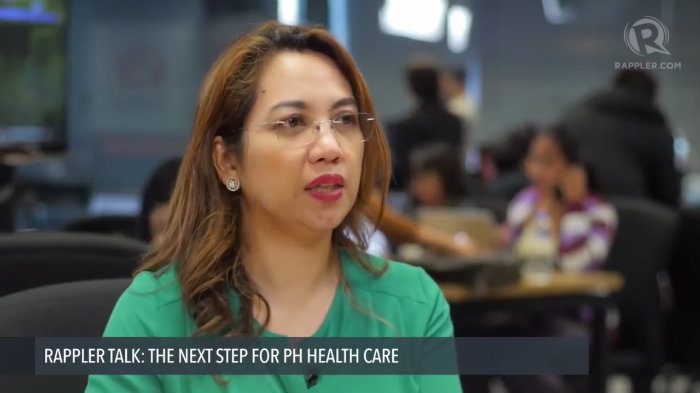SUMMARY
This is AI generated summarization, which may have errors. For context, always refer to the full article.

MANILA, Philippines – On Rappler Talk on Tuesday, June 14, outgoing Department of Health (DOH) Secretary Janette Garin denied that the Dr Jose Fabella Memorial Hospital will be demolished.
“Fabella will not be closed. No employees will be terminated or displaced. It is not a public-private partnership (PPP) project,” Garin clarified.
Garin explained that the DOH assigned hospitals to accept overspill patients coming from the Fabella hospital to avoid congestion. This advisory came amid findings from different institutions – Manila City Hall, Department of Public Works and Highways (DPWH), and a private engineering company called ESCA – that 4 out of Fabella’s 8 buildings are structurally unsound.
Early in June, health workers wrote a letter urging President-elect Rodrigo Duterte to stop the closure of the national maternity hospital. The Save Fabella Hospital Movement (SFM), together with the Alliance of Health Workers, also staged protests against the reported “demolition” of the hospital for “commercial use.”
Fabella Hospital has been in operation for 65 years already. The 109-year building which houses the hospital used to be part of the Bilibid prison. It is currently located within the 8.42-hectare Old Bilibid Compound in Sta Cruz, Manila.
In 2007, the compound was sold to Home Guaranty Corporation (HGC) under former president Gloria Macapagal Arroyo.
Real deal
Health activists and workers have been staging a series of protests triggered by reports of alleged plans to demolish the hospital on June 9. The demolition did not happen last Thursday.
Employees and patients of Fabella coming from poor communities and far-flung provinces also feared that the hospital, which is dubbed the “Paanakan ng Bayan” (National Maternity Hospital), will be abolished.
“Every now and then, you see people complaining that is congested. It’s called the baby factory. You see mothers and babies lying down beside each other. It is shameful to say that we love our mothers and children yet we deprive them of quality healthcare during birth,” Garin clarified in a mix of Filipino and English.
Fabella hospital accommodates about a hundred mothers on a daily basis, while around 1,000 obstetrical and gynecological in-patients share the hospital’s 700-bed facility.
“The demand is increasing but you have a congested area. The land is also not ours,” Garin noted.
To address these problems, Garin said that the DOH plans to move and build a better hospital for birthing mothers. The new Fabella hospital that will rise in Quezon City will be a 6-storey building with 800-bed capacity.
Garin also assured the public that there is enough budget that will be allocated for the construction, facilities, and human resources of the new and modernized Fabella hospital in the next two years.
Since the hospital will be moving into a bigger facility, Garin denied that employees will be terminated. On the contrary, she said that the health department is planning to add more line items for human resources at the Fabella hospital next year.
The construction, which started in December 2014, is expected to be completed by next year.
Privatization?
However, health groups believe that the decision to move the Fabella hospital is a way to privatize the health facility, which in turn will lead to the disenfranchisment of poor and indigent patients who depend on public healthcare.
Garin clarified that it is exactly the demand for accessible healthcare which prompted the health department to expedite its modernization plan for Fabella.
Garin said that “while there was a PPP proposal similar to the Philippine Orthopedic Hospital,” she had it terminated when she assumed the position.
Garin officially replaced former health secretary Enrique Ona in December 2015. Ona resigned from the post in 2014.
“Yes, there were proposals for a PPP but when I took over, I realized that it is possible for the government to fund it,” Garin added.
Garin said that she terminated the PPP proposal of the Japan International Cooperation Agency (JICA) because it required pooling the laboratory or the diagnostic centers of the tri-medical complex – San Lazaro, Jose Reyes, and Fabella hospitals – to the private sector.
“That’s the bread and butter of the hospital. If you give that to the private sector, how can you make healthcare sustainable?” she said.
Garin added that privatization of hospitals runs the risk of allowing the private sector to pass on its profit-oriented goals to the public – a view shared by many of the health groups protesting against the alleged demolition of the Fabella hospital.
Modernization
“The difference between a modernization and PPP, in a modernization project, you improve the facilities and hire more employees. In PPP, you let the private sectors invest. Once you let them invest, there is no free lunch. When they invest, their intention will always be to earn profit. They will pass that on to the patient,” Garin said in a mix of English and Filipino.
She gave assurances that the services will remain affordable and accessible especially to poor families in need of quality healthcare.
“Many were anxious. What if the next administration revives the PPP project? If that happens, I will join them in questioning the move,” Garin said.
Dr Paulyn Jean Rosell Ubial will lead the health department in the next 6 years under the Duterte administration. – Rappler.com
Add a comment
How does this make you feel?





There are no comments yet. Add your comment to start the conversation.